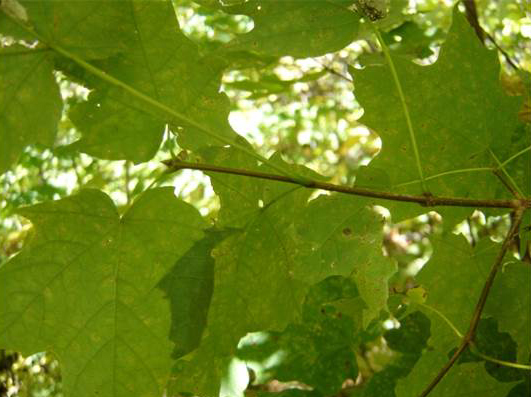Health of Sugar Maple Trees
Jun. 26th 2014Acid deposition in conjunction with a changing climate may be inhibiting growth of sugar maple (Acer saccharum Marsh.) in northeastern forests. Long-term acid rain deposition has led to soils that are slightly acidic in the region. Calcium is leached from the soil in these acidified conditions. Calcium is a necessary macronutrient for forest health, impacting tree structural integrity, woody growth, and stress response. In addition to less calcium availability in soils, aluminum becomes more readily available to trees under acidifying conditions. Calcium and aluminum compete with each other to be taken up by tress. However, aluminum is toxic to plants and its uptake can lead to less healthy trees that are more susceptible to other stresses, such as drought, excessive heat, or freezing soil. Joshua Halman, of the Rubenstein School of Environment and Natural Resources at the University of Vermont, and others studied sugar maples in the Hubbard Brook Experimental Forest in New Hampshire. Calcium was added to some plots, and aluminum to others, while also maintaining control plots. A loss of calcium from soil is caused by long-term acid rain deposition. Calcium was added to remediate plots to pre-pollution levels, representing past forest conditions. The control plots represent current forest conditions, and aluminum addition tests future forest conditions given continued acid deposition. Treatments began in 1995, adding calcium biannually for three years, and ceasing after a one-time, slow-release addition in 1999. Aluminum was added annually 1995-1999, and less regularly 2001-2011. Sugar maple roots, canopy foliage, carbon resources, spring frost, and reproductive success were assessed from 2008-2010. The experimental plots can be used in predicting future northeastern forest health. Continued acid deposition, in conjunction with climate change, places sugar maples at risk for many injuries and decreased health and growth. There were significant differences among calcium-treatments, control plots, and aluminum-treatments, including:
- Greater concentration of aluminum in Al-plots, resulting in injury to roots
- No difference in aluminum concentration in foliar tissue among all treatments, due to binding of aluminum to roots and limited transport to other
- Carbon pools available for growth in trees in Ca-plots, control and Al-plots had less carbon available that was needed for defense
- Regrowth of foliage in Ca-plots following late frost damage, control and Al-plots were less able to regrow foliage
- Seed production was reduced in Al-plots, resulting in 7-fold fewer germinants per plot than Ca-plots
In a changing climate regime coupled with continued acidification, sugar maples could be at a disadvantage with continued exposure to acidic inputs because earlier bud break places them at an increased risk of damage and inability to produce a second flush in variable climate conditions. Reproductive capability was also identified as being impacted by aluminum addition. Current conditions do not indicate that native forests are at risk of reduced productivity, however, if acid deposition continues, northern forests may not be sugar maple dominated, other species that are better able to survive in low pH soils may begin to dominate, such as American beech. In a changing climate regime coupled with continued acidification, sugar maples could be at a disadvantage with continued exposure to acidic inputs because earlier bud break places them at an increased risk of damage and inability to produce a second flush in variable climate conditions. Reproductive capability was also identified as being impacted by aluminum addition. Current conditions do not indicate that native forests are at risk of reduced productivity, however, if acid deposition continues, northern forests may not be sugar maple dominated, other species that are better able to survive in low pH soils may begin to dominate, such as American beech.
 ecoNEWS VT
ecoNEWS VT